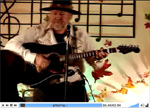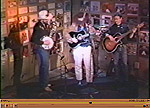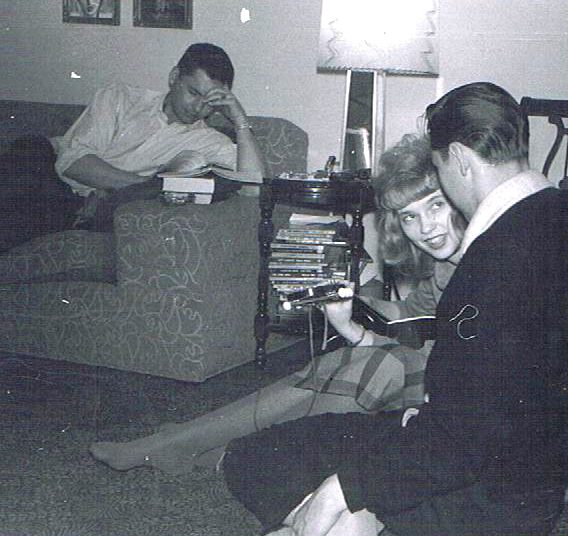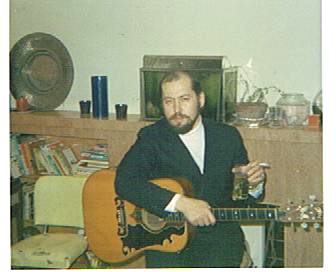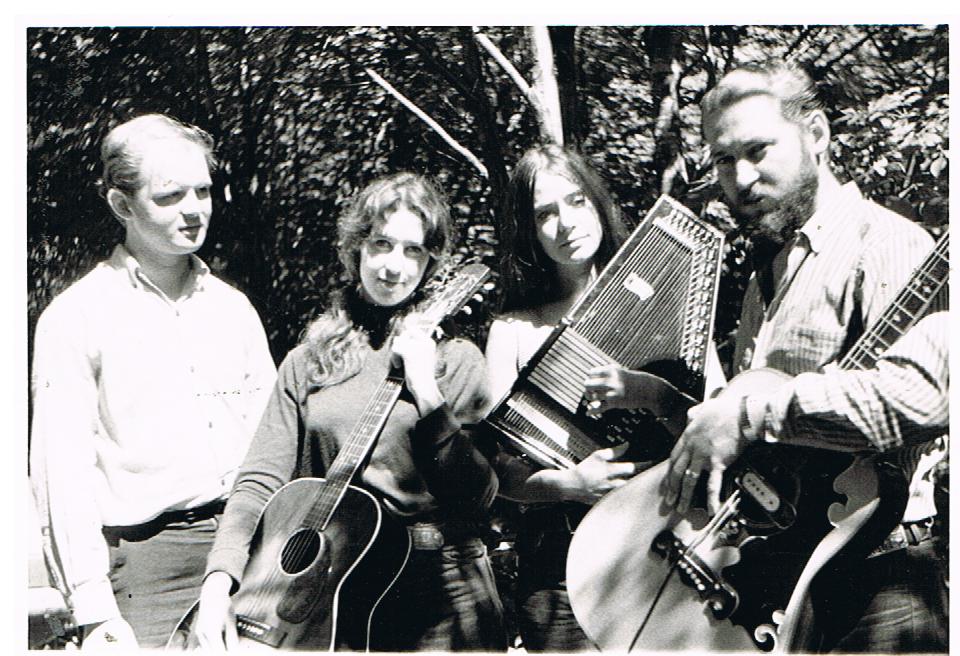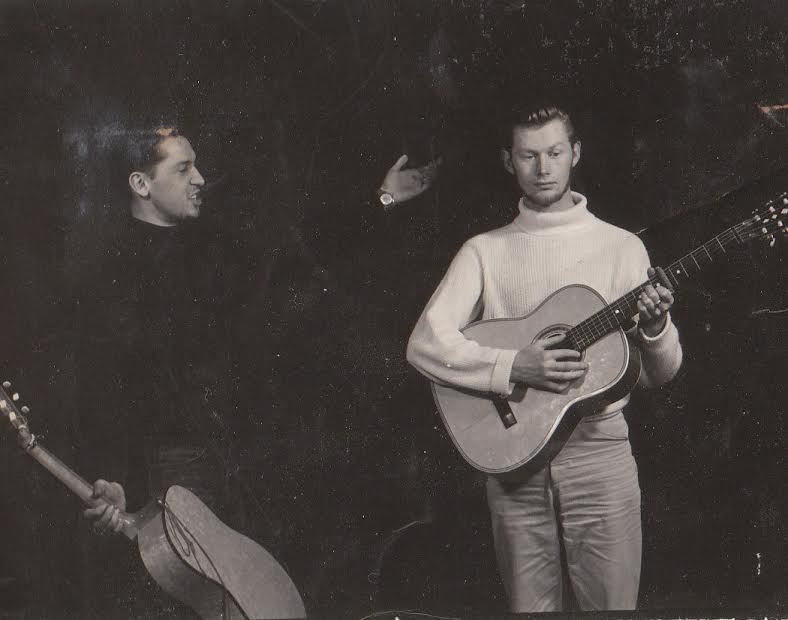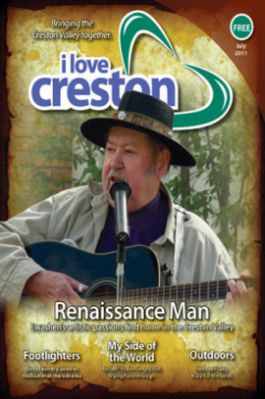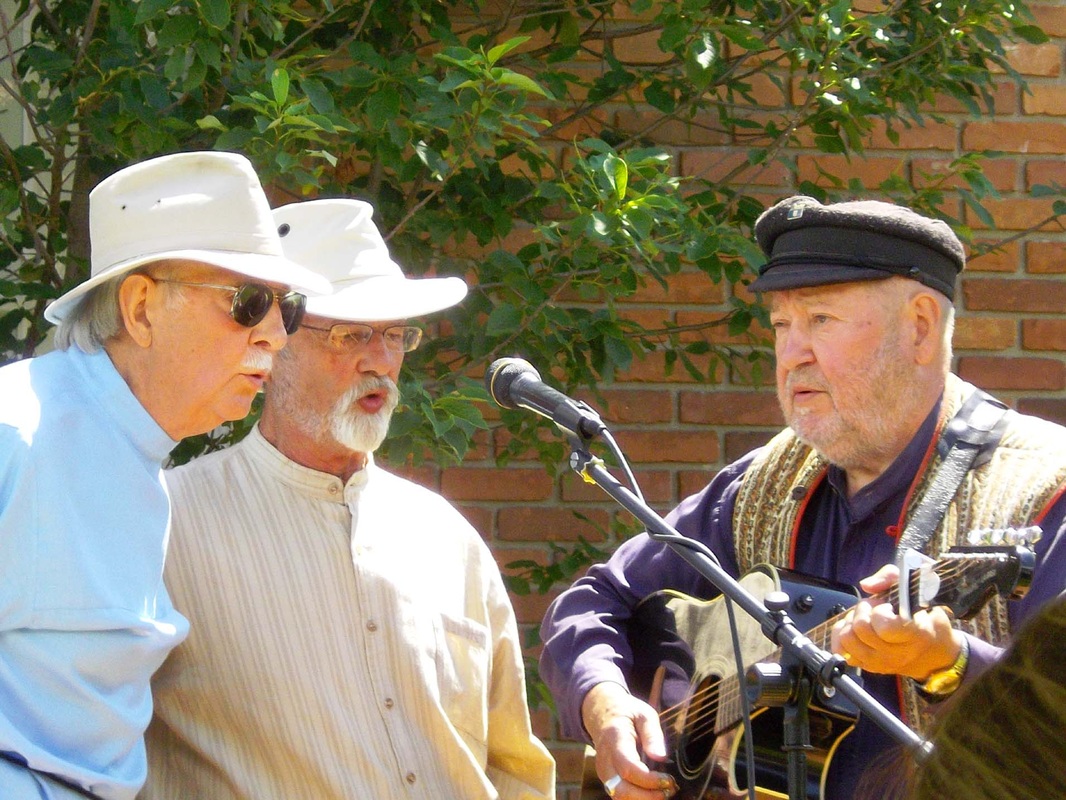My first professional years were spent in Toronto and were devoted to performing, basically part of the folk revival, the coffee houses and listening pubs. This turned into travelling and singing with various groups concentrating on country and bluegrass. During this time I also worked as an accompanist for other singers and did some sound tracks for film as well as studio work backing other singers.
After graduate school I worked steadily as an actor and director in theatre and film, but continued my musical interests, and often integrated music into shows and did musicals including many original Canadiana productions.
During this time I also continued writing songs and jamming with like minded individuals whenever the occasion presented itself. Returning to the west I continued with music, most notably Commercial Drive in Vancouver, which grew out of a weekly folk song circle. Continuing to teach and play guitar I also revived the early immersion in Russian folk music with my brothers. A sample of this genre is included in this tab. In a recent open stage at the Snoring Sasquatch in Creston I was chatting with a musical colleague and realized that I had been performing for sixty-five years! Some of the images included on this site will show some of my earlier performances and groups. As time passes, more music and photos will be added.
After graduate school I worked steadily as an actor and director in theatre and film, but continued my musical interests, and often integrated music into shows and did musicals including many original Canadiana productions.
During this time I also continued writing songs and jamming with like minded individuals whenever the occasion presented itself. Returning to the west I continued with music, most notably Commercial Drive in Vancouver, which grew out of a weekly folk song circle. Continuing to teach and play guitar I also revived the early immersion in Russian folk music with my brothers. A sample of this genre is included in this tab. In a recent open stage at the Snoring Sasquatch in Creston I was chatting with a musical colleague and realized that I had been performing for sixty-five years! Some of the images included on this site will show some of my earlier performances and groups. As time passes, more music and photos will be added.
PEACE SONG
Larry Ewashen
Music has been part of my life for as long as I can remember and was probably imbued within me while I was in my mother’s womb in Southern Alberta. She and dad were both excellent singers and often sang together; born in Canada but preserving their Russian culture including a commitment to pacifism. Growing up in the Doukhobor milieu, my first exposure to song was Russian folk songs and Doukhobor hymns. These were meditative chants which brought peace and solace to these pacifist dissidents along their historical thorny path of exile and re-settlement.
The quote from William Congreve: ‘Music has charms to soothe the savage breast’, in their estimation, was quite literally true and is best expressed by the following abridged Doukhobor psalm:
Singing of Psalms is an adornment to our souls.
They form a union of love, give you power of observing and strength of fulfilling all.
It all indicates a great soul.
It cleanses one's lips and makes one’s heart glad.
To the ones who have perfection it shows the way.
Serenity of the mind is a herald of peace:
The Psalms express prayer for future generations.
To the elders it is a sign of comfort.
To the young it is an improvement of their mind.
From my formative years onward, from the country school square dances to the concert stage, I never believed that music and songs were just entertainment. In my experience, as a performer and singer for seventy years, music has been a vital life force.
Moreover, music and peace were inextricably intertwined. Early activism with the Campaign for Nuclear Disarmament included rallies which provided stages for many peace songs, echoing the civil rights movement and anti-Vietnam war protests. The folk movement featured seminal peace songs written by Canadians such as Ed McCurdy’s Strangest Dream and Buffie St. Marie’s Universal Soldier which ranked along side Pete Seeger’s We Shall Overcome and John Lennon’s Give Peace a Chance and Imagine! Throughout the years, these songs sustained our demonstrations and strengthened our resolve through sometimes abusive encounters.
After several productive years as the Curator of The Doukhobor Discovery Centre in B. C. where I featured many peace manifestations ranging from the UN Peace Day to Hiroshima Day and many Doukhobor choirs with their emphasis on holistic living and pacifism, I also revived the early immersion in Russian folk music with my two brothers, which again included peace songs at various events and rallies.
The Doukhobor manifestation for Peace reached a zenith when they celebrated the 100th anniversary of the famous Arms Burning of 1895 on the Russian steppes which led to their exodus to Canada.
With pageant and song, the over seventy member company United Doukhobor Centennial ‘95 Choir and Drama Ensemble presented Voices for Peace, 1995 International Tour, travelling across Canada with presentations from B. C. to Ottawa including a performance at the Canadian Museum of Civilization, the United Nations in New York and then in Russia with their multimedia event. The project was a historic bridge between the different groups of Doukhobors in Canada as well as a Canada - Russia peace bridge.
Throughout my life, music with its expression of peace and harmony, has been an integral and sustaining force, which helped present our goals while being a sustaining force in daily life.
Larry Ewashen
unities and beyond.
Larry Ewashen
Music has been part of my life for as long as I can remember and was probably imbued within me while I was in my mother’s womb in Southern Alberta. She and dad were both excellent singers and often sang together; born in Canada but preserving their Russian culture including a commitment to pacifism. Growing up in the Doukhobor milieu, my first exposure to song was Russian folk songs and Doukhobor hymns. These were meditative chants which brought peace and solace to these pacifist dissidents along their historical thorny path of exile and re-settlement.
The quote from William Congreve: ‘Music has charms to soothe the savage breast’, in their estimation, was quite literally true and is best expressed by the following abridged Doukhobor psalm:
Singing of Psalms is an adornment to our souls.
They form a union of love, give you power of observing and strength of fulfilling all.
It all indicates a great soul.
It cleanses one's lips and makes one’s heart glad.
To the ones who have perfection it shows the way.
Serenity of the mind is a herald of peace:
The Psalms express prayer for future generations.
To the elders it is a sign of comfort.
To the young it is an improvement of their mind.
From my formative years onward, from the country school square dances to the concert stage, I never believed that music and songs were just entertainment. In my experience, as a performer and singer for seventy years, music has been a vital life force.
Moreover, music and peace were inextricably intertwined. Early activism with the Campaign for Nuclear Disarmament included rallies which provided stages for many peace songs, echoing the civil rights movement and anti-Vietnam war protests. The folk movement featured seminal peace songs written by Canadians such as Ed McCurdy’s Strangest Dream and Buffie St. Marie’s Universal Soldier which ranked along side Pete Seeger’s We Shall Overcome and John Lennon’s Give Peace a Chance and Imagine! Throughout the years, these songs sustained our demonstrations and strengthened our resolve through sometimes abusive encounters.
After several productive years as the Curator of The Doukhobor Discovery Centre in B. C. where I featured many peace manifestations ranging from the UN Peace Day to Hiroshima Day and many Doukhobor choirs with their emphasis on holistic living and pacifism, I also revived the early immersion in Russian folk music with my two brothers, which again included peace songs at various events and rallies.
The Doukhobor manifestation for Peace reached a zenith when they celebrated the 100th anniversary of the famous Arms Burning of 1895 on the Russian steppes which led to their exodus to Canada.
With pageant and song, the over seventy member company United Doukhobor Centennial ‘95 Choir and Drama Ensemble presented Voices for Peace, 1995 International Tour, travelling across Canada with presentations from B. C. to Ottawa including a performance at the Canadian Museum of Civilization, the United Nations in New York and then in Russia with their multimedia event. The project was a historic bridge between the different groups of Doukhobors in Canada as well as a Canada - Russia peace bridge.
Throughout my life, music with its expression of peace and harmony, has been an integral and sustaining force, which helped present our goals while being a sustaining force in daily life.
Larry Ewashen
unities and beyond.
CONCERT AT MILLENNIUM PARK!
CDS DAY OF LOVE FEATURES TRIBUTE TO PETE SEEGER
On February 16th, 2014, at Tarrys Hall, the Canadian Doukhobor Society annual Day of Love featured remembrances of Pete Seeger throughout the program.
Larry Ewashen read the following poem he had written for the occasion at the beginning of the afternoon program:
REMEMBERING PETE SEEGER
I dreamed I saw Pete Seeger last night - As live as you and me
Said I: But Pete, you’re dead and gone - I never died said he
I’m with you when the people sing - And bring us all in harmony
The place where people meet in peace - Is where I will always be
It was 94 years of ups and downs - But I had a spark to carry on
And a long road trekked with many friends - Never without a song
Forward for the rights of men - And dignity wide and far
And not just for the money - Not just to be a star
But as fame and fortune beckoned - I fought for causes dear to me
And the songs from all the humble folk - Were now revealed for all to see
I was the Johnny Appleseed - Saving the people’s song
When they didn't come to me - I searched them out, brought them along
I was asked if I sang for the commie camp - I sang where ever people listened
I offered to sing for them too, but they wouldn't let my banjo glisten
So they banned me from the air waves - I played out on the street
Schools, stages, camps and union rallies - Where ever people meet
The good music in this world may save the planet - If we take time to hear the beat
And the toilers and the righteous - Will meet at god’s all mighty seat
We made an audience for: People’s music of the world
And joining in unison - The flag of brotherhood unfurled
So where people of good will are gathered - To share food and to sing
I’ll never die, I’ll be there too - And you’ll hear my banjo ring . . .
TWO RUSSIAN SONGS ~ EWASHEN TRIO
video by Glynnis Ewashen
video by Glynnis Ewashen
EWASHEN BROTHERS TRIO AT BRILLIANT BENEFIT CONCERT
Saturday, November 9th, saw a benefit concert at the Brilliant Hall in Castlegar. Ewashen Brothers Trio performed among a two hour program featuring local artists, videos and slide shows.
The benefit was produced by Verna Postnikoff, shown above, in aid of Georgian Doukhobors. Funds raised will go towards farm tools and other needy items for the Doukhobors in Georgia. Images and a video from Georgia were also featured at the concert and Verna continues the fund raising through sales of card images that she took on her visit there.
The benefit was produced by Verna Postnikoff, shown above, in aid of Georgian Doukhobors. Funds raised will go towards farm tools and other needy items for the Doukhobors in Georgia. Images and a video from Georgia were also featured at the concert and Verna continues the fund raising through sales of card images that she took on her visit there.
The Wynndel Coffeehouse is held at the Wynndel Community Hall on the second Saturday of every month from September to May. Coffee and snacks are served, admission is charged, except for musicians. All proceeds go towards the upkeep of the hall and the staff consists of community volunteers. The entertainment consists of local musicians featuring all types of music. It is a highly successful community venture and celebrated its tenth year in 2011. (Thanks to Glynnis Ewashen for the video!)
TRAVEL WITH STOMPIN' TOM

Album Cover
In my earlier career I worked with Stompin’ Tom Conners and his recording of How The Mountain Came Down . . .
How The Mountain Came Down
Tom and I, along with Bud Roberts (a.k.a. Bud the Spud) were on a tour through Northern Ontario and Quebec. After the evening's performance we usually had a 'wind down' with a few beers and much discussion. One such evening, I read him my poem:
His immediate reaction was 'I can make a song out of that!' I said by all means, and forgot all about it. It appeared on his next album, 'On Tragedy Trail', and it also appears on 'Stompin Tom Sings Canadian History'. This song, part song, part dramatic recitation, has been widely performed in his concerts, including a nation wide television broadcast.
The song is credited as written by Tom Connors and Larry West. Working in Ontario I used two different names, Larry Ewashen for theatre and film, and being known and recognized as coming from the west, Larry West for folk and country music. Larry West was quick and effective for pronouncing and understanding over a microphone and was also easy to remember.
[How the Mountain Came Down. Written by T.C. Connors and Larry West © 1968 Crown-Vetch Music SOCAN, All Rights Reserved. Tragedy Trail Album Cover 1969 Stompin' Tom Ltd. All Rights Reserved]
How The Mountain Came Down
Tom and I, along with Bud Roberts (a.k.a. Bud the Spud) were on a tour through Northern Ontario and Quebec. After the evening's performance we usually had a 'wind down' with a few beers and much discussion. One such evening, I read him my poem:
His immediate reaction was 'I can make a song out of that!' I said by all means, and forgot all about it. It appeared on his next album, 'On Tragedy Trail', and it also appears on 'Stompin Tom Sings Canadian History'. This song, part song, part dramatic recitation, has been widely performed in his concerts, including a nation wide television broadcast.
The song is credited as written by Tom Connors and Larry West. Working in Ontario I used two different names, Larry Ewashen for theatre and film, and being known and recognized as coming from the west, Larry West for folk and country music. Larry West was quick and effective for pronouncing and understanding over a microphone and was also easy to remember.
[How the Mountain Came Down. Written by T.C. Connors and Larry West © 1968 Crown-Vetch Music SOCAN, All Rights Reserved. Tragedy Trail Album Cover 1969 Stompin' Tom Ltd. All Rights Reserved]












